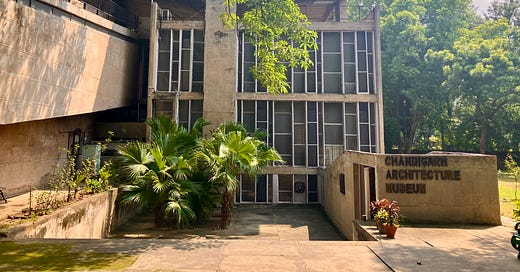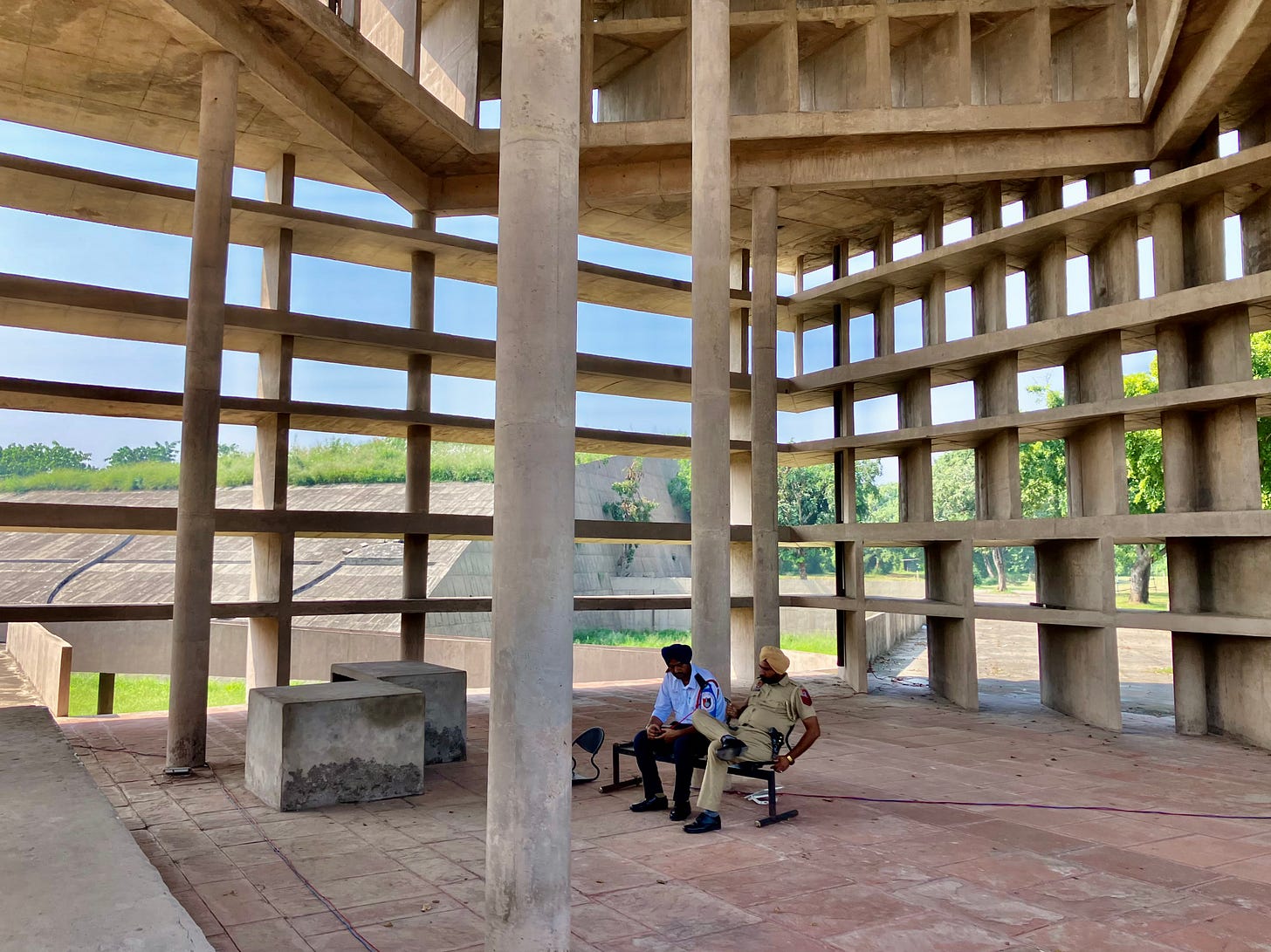Numb in India, part 2: The city beautiful
Modernist utopia, Vedic sacrifice, and the terrible secret of the Sun
Once again, Numb at the Lodge is on holiday. Paid subscribers can join us in a brain-melting tourist odyssey across the past and future of Indias real and imagined. The really good stuff is behind the paywall: this time, it’s about an ancient royal horse-sacrifice and the universe made of horses. If you want to come along, all you have to do is click the button below:
Today I’m writing from Chandigarh, the purpose-built capital of Punjab and Haryana. After Partition, the traditional Punjabi capital of Lahore ended up in Pakistan, and communal rioting had left much of the state in ruins. Chandigarh was the solution: a new, modern city for a new, forward-looking country. It was designed by the notorious Franco-Swiss architect Le Corbusier: you might remember him from his slightly supervillainish plan to demolish the entire Left Bank of Paris and replace it with dozens of huge, evenly-spaced cruciform housing blocks. For some reason, the Parisian authorities never let him follow through on that one, but Nehru gave him Chandigarh: the largest single project he ever completed, a city-sized laboratory for his ideas. Locals call Chandigarh the city beautiful, and they’re right. It is beautiful. I just worry that it might also be a psychic interface communicating with the unknown entity at the heart of the Sun.
A lot of people respond very negatively to Le Corbusier, and I do understand why. His real name was Charles-Édouard, but he insisted that everyone call him by a made-up name that essentially translates as The Crowlike One. This is annoying. His designs make heavy use of raw concrete, which not everyone finds appealing, and he supported the Nazis. He had a habit of making big, airy, arsey pronouncements, and if you’re not predisposed to like him I can get why these might get under your skin. ‘The curve is ruinous, difficult and dangerous; it is a paralysing thing. The straight line enters into all human history, into all human aims, into every human act.’ That sort of thing.
Critics have detected something deeply authoritarian in Le Corbusier’s efforts to replace all haphazard, organic, democratic forms with a world of summarily imposed right-angles and grids. The late James C Scott, for instance, made Le Corbusier one of the chief villains of his book Seeing Like A State, which is about all the ways big top-down ‘scientific’ projects to improve the world have ended up making things drastically worse. So he cites the example of Brasilia: another planned capital built on Le Corbusier’s principles, ‘conceived as a city of the future, a city of development, a realisable utopia. It made no reference to the habits, traditions, and practices of Brazil’s past or its great cities.’ In particular, it lacked streets, the sense of a universal public space with no strict function except whatever you feel like doing today. In most Brazilian cities, the street is where children play, friends drink coffee, traders do their business, men and women discover each other; where religion and revolution are preached, and sometimes enacted. Brasilia has no streets, ‘only roads and highways.’ The plan provides for everything; nothing unplanned can ever take place. But every human life is made up of a million accidental miracles, and Brasilia is no place for human life. Today, it’s virtually abandoned; anyone who can moves to the more gregarious suburbs. Scott devotes a long section of his book to Brasilia. Chandigarh, meanwhile, barely gets a single page in my edition. This is strange, since unlike Brasilia, Chandigarh was designed by Le Corbusier himself, rather than his followers. Maybe the problem is that unlike Brasilia, Chandigarh works.
It’s nice here: overwhelmingly nice. In Sector 17, the downtown zone, a network of open passages leads between generous chowks where families wander around on a Saturday night, eating ice cream, listening to street musicians. Apparently the city has a big microbrew culture. There’s a wide underpass beneath one of the main arterial highways, where ten-year-old kids practice their rollerblading. On the other side there’s an immaculate park so muscular Sikhs can jog around the enormous fountain in the Sunday-morning cool. On the highway above, cars wait for the green light at intersections and everyone wears their seatbelt. There are no piles of refuse on the streets in Chandigarh. No wandering urban cattle. (To be fair, one person has given the entire city a one-star Google rating and added that ‘the name should be changed from “The city beautiful” to “THE CITY OF STRAY DOGS.”’) As you leave Delhi the train heaves past the slums, the truly desperate places, where every family home is a brick cube eight feet in each direction, without windows or water or electricity, just the baking fetid air and a mattress on the floor, and there are huge tracts of city that are nothing but these brick coffins piled on top of each other like a heap of Lego, all of them in a sea of stinking plastic waste that surges against each dark and doorless door. There’s nothing like that in Chandigarh. The city has some informal settlements on its outskirts and a few warrenlike old villages engulfed in its grid, but the vast majority of the migrant workers live in multi-room apartments in concrete blocks, with greenery all around them and big glass windows that let in lots of light.
The big monumental zones of Chandigarh are incontrovertibly beautiful. There’s a certain type of person that can’t see a bit of raw concrete without frothing about ugliness and decadence and the plot to enslave the soul of western man, and they always seem to think I’m being some kind of devious contrarian when I say I find this stuff straightforwardly aesthetically pleasing, but I do, and I’m right. If you can’t appreciate the value of clean lines and pure geometric forms, I don’t really feel any need to take your opinions seriously. So far, I’ve never seen anyone actually explain why modern architecture is so intrinsically ugly. According to the traditional definition, beauty is symmetry, harmony, and proportion, and Le Corbusier’s buildings have all of those. The museums he designed for Chandigarh are gorgeous spaces, airy, well-proportioned. His Palace of Assembly is a masterpiece: the lawmakers sit under an enormous funnel, bands and blobs of colour rising into an almost infinite blackness that towers above the parliamentarians in their seats and makes all these grandees look very, very small. It conjures an awe I’ve only experienced in a few very old cathedrals. But maybe my favourite thing here is the Tower of Shadows, and not just for its cool sinister name. The Tower consists of two open concrete-lattice cubes stacked on top of each other, but the slats are positioned at a very precise angle relative to the Sun. In the summer, they ensure that the Tower is always in the shade at any time of day; in the winter, when the Sun is lower in the sky, the light streams in. The entire form of the building is given by invisible lines of sunlight, rendered in concrete. If you can’t find that beautiful, I think something might be missing in your soul.
It’s the other parts of Chandigarh I find harder to explain. The bits that aren’t UNESCO world heritage sites, where the city has been left to develop along its own path. This place is—there’s no other word for it—Californian. A hazy, pastel vision of Southern California, self-assembling on the flat fields of the Punjab. It’s in the long, straight, palm-lined avenues, the traffic zooming through a city built less to be lived in and more to be driven through. Music leaks out the open windows at red lights: bhangra vocals over a G-funk beat. The road runs straight forever, but past vanishing point great green mountains loom. For a moment you could pretend they’re the San Gabriels, not the first foothills of the Himalayas from which the Ganges flows. Around sunset everyone gathers by the lake. All the politicians used to be singers or movie stars. We are in Los Angeles. Just look at this place:
But maybe I’ve got things backwards. After all, India is older than California, and the first Europeans had barely settled on the eastern shore of the Pacific when they suddenly started getting obsessed with Hindu mysticism. Swami Vivekananda could draw huge crowds in Los Angeles when it was still a cow town. Something of India repeats itself there. We’ll return to this mystery eventually, but as it happens, Chandigarh is not India’s first planned city laid out on a perfect grid. Le Corbusier might have thought he was replacing the irrational squalor of the Indian city with a new and pure form, but actually he was part of a long tradition. Two centuries before Le Corbusier, and fifty years before the United States of America, there was Sawai Jai Singh II, the great king who discovered how to communicate with the Sun, and learned what it said, and lived in abject terror for two years until he died.






